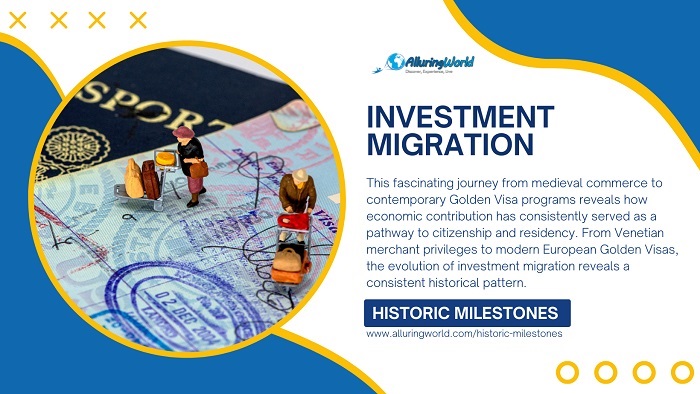Read time ca. 3 minutes
In 14th century Venice, wealthy merchants could purchase special trading privileges that granted them residency rights in foreign territories – a practice that would become the foundation of modern investment migration.
This fascinating journey from medieval commerce to contemporary Golden Visa programs reveals how economic contribution has consistently served as a pathway to citizenship and residency throughout history.
Ancient Foundations: Commerce and Citizenship
The concept of earning residency through economic contribution traces back to ancient civilizations. Roman emperors frequently granted citizenship to wealthy foreigners who made substantial contributions to the empire’s infrastructure or military campaigns. These early practices established the precedent that financial investment could unlock legal status and mobility rights.
Medieval guilds later formalized these arrangements, creating structured systems where merchants could gain privileges in foreign cities through predetermined economic contributions. These guild privileges often included residency rights, trading licenses, and legal protections – remarkably similar to modern investor visa benefits.
Renaissance Revolution: City-States and Investment
The Italian Renaissance marked a pivotal moment in investment migration history. Venice, Florence, and Genoa developed sophisticated programs that attracted foreign capital through residency incentives. Venetian merchants, for instance, could secure long-term residency in Constantinople or Alexandria by establishing trading posts and making substantial investments in local infrastructure.
Florence’s banking houses pioneered what we now recognize as investment migration frameworks, offering foreign investors residential status in exchange for capital deployment in textile manufacturing and banking operations. These programs generated significant economic growth while creating the first formal documentation systems for investment-based residency.
Modern Emergence: Post-War Economic Programs
The 20th century witnessed the formalization of investment migration through government-sponsored programs. Following World War II, several nations began offering structured investor visas to rebuild their economies and attract foreign capital.
Caribbean nations became early pioneers in modern economic citizenship, with countries like St. Kitts and Nevis launching formal citizenship-by-investment programs in the 1980s. These programs established the template for contemporary investment migration, featuring clear investment thresholds, due diligence requirements, and defined benefits.
Contemporary Landscape: The Golden Visa Era
Today’s investment migration landscape has evolved into a sophisticated global industry. European Golden Visa programs, launched in the 2010s, transformed international mobility by offering EU residency through real estate investments, government bonds, or business ventures.
Portugal’s Golden Visa program, initiated in 2012, exemplifies this modern approach by providing a clear pathway to European residency and eventual citizenship through structured investment options. Spain, Greece, and other EU nations followed with similar programs, creating unprecedented opportunities for global mobility through economic contribution.
These contemporary programs continue the historical tradition of linking investment to residency while incorporating modern due diligence, regulatory compliance, and economic impact assessments. For investors evaluating these opportunities, understanding the comprehensive landscape of golden visa options becomes essential for making informed decisions about their global mobility strategy.
From Venetian merchant privileges to modern European Golden Visas, the evolution of investment migration reveals a consistent historical pattern: economic contribution as a pathway to mobility and legal status. This millennium-spanning journey demonstrates how investment migration has adapted to changing political landscapes while maintaining its core principle of mutual benefit between investors and host nations.
As global mobility continues evolving, these historical precedents provide valuable context for understanding how investment migration programs will likely develop in the coming decades, maintaining their role as bridges between capital, opportunity, and citizenship.
Conclusion
Throughout history, from Roman emperors to Renaissance city-states and modern nations, the link between economic contribution and legal status has remained a constant. The evolution of investment migration demonstrates a continuous adaptation of this principle, moving from informal privileges for wealthy merchants to the highly structured, regulated Golden Visa and citizenship by investment programs we see today. Ultimately, this historical journey confirms that the mutual benefit of capital, opportunity, and citizenship will likely continue to shape the future of global mobility.

